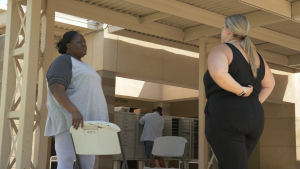- Slug: BC-CNS Money for Homelessness, 860 words.
- 1 video here, credit Balin Overstolz-McNair.
- 1 photo and caption below.
By Balin Overstolz-McNair
Cronkite News
PHOENIX – Since the beginning of the COVID-19 pandemic in March 2020, Maricopa County has received more than $2.2 billion in federal relief funds to help the Maricopa Association of Governments and other organizations combat homelessness and stabilize the housing market for vulnerable populations.
Part of those funds will go to creating specialized homeless shelters and more temporary housing, with the help of nonprofit organizations around metro Phoenix.
Maricopa is the fastest growing county in the country, and its homeless populations also are growing, according to the 2020 Point-in-Time Count.
“The influx of federal money has allowed us to think outside the box, thinking of ways we can serve people in different areas,” said Nicky Stevens, regional homelessness program manager for the Maricopa Association of Governments, known as MAG. “We have been working alongside with municipalities on hotels, temporary shelters.”
The MAG Continuum of Care Committee, which organizes regional initiatives to end homelessness, now is focused on a housing-first approach to the problem. Its goal is to get those experiencing homelessness off the streets as soon as possible.
The committee also is working with landlords and nonprofits, including Homeward Bound and United Methodist Outreach Ministries, known as UMOM, to put people in homes and reduce the unsheltered homeless population. More than 3,700 people are unsheltered, representing slightly over half the total homeless population in the Phoenix area, according to the 2020 Point-in-Time Count. MAG considers anyone living on the streets or “other places not meant for human habitation” to be unsheltered.
The annual headcount was not conducted in 2021 because of the pandemic and concerns about working with vulnerable populations.
A significant contributor to homelessness in the Valley is the lack of affordable housing, which Stevens called the committee’s biggest challenge. Low wages also are a problem.
“One of the assumptions about homeless people is that they don’t work, and that’s just not true,” Stevens said. “They don’t make enough to afford any of the apartment communities currently in the region.”
According to rentcafe.com, which tracks rental properties, the average two-bedroom apartment in Phoenix rents for $1,408 a month, which is up 21% over the previous year.
With uncertainty and legal battles surrounding the expiration of the national eviction moratorium, renters in metro Phoenix will be under even more pressure.
In 2019, Samantha Bedford was struggling to find a rent price point that worked for her and her three children. She eventually moved into an apartment, but the experience proved difficult.
Nine months after moving in, Bedford was injured in a car accident, which she said prevented her from working her normal number of hours. The property manager was unwilling to make arrangements, Bedford said, and even after she offered to move out by the end of the month, she received an eviction notice despite already being in bankruptcy.
A judge would not sign the eviction order because Bedford was in bankruptcy but ordered her and her three young children to move out by 5 p.m. that day.
“We were homeless,” Bedford recalled. “My mother, thankfully, was here and my kids were allowed to stay with her. But, of course, I couldn’t – because of her apartment complex and where she lived.”
Bedford slept in her car outside the apartment complex and spent the mornings with her kids – ages 2, 3 and 7 – in her mother’s apartment, preparing them for the day.
Even before she was injured, Bedford had difficulties keeping up with rent and additional fees. She said the experience was so stressful that she simply couldn’t have stayed there any longer.
For Bedford, who already was living in affordable housing, there were no other options. But she didn’t give up and eventually found the nonprofit Homeward Bound.
“You have to use your voice, whether someone is going to listen or not,” Bedford said. “If you can’t get through to one, keep pushing ’cause somebody is going to hear you. So it doesn’t matter how many rejections I got from different apartment complexes, when I came here I got the yes.”
Homeward Bound provides apartment-style housing for families experiencing homelessness or financial need. Case workers teach residents about budgeting and communication and strive to improve the lives of residents. It’s one of several nonprofit organizations that work with Maricopa County to collect data on and house those experiencing homelessness.
Homeward Bound has 76 housing units, which are dwarfed by the more than 3,000 reported unsheltered homeless in the Valley – a number that experts say is likely underreported. Homeward Bound represents one way where the city is trying to combat homelessness: Work with local organizations to better create a regional system that can help house and support the growing homeless population.
Bedford, who regularly attends classes with case managers, said she has a better understanding of how to budget money and communicate with her kids. She’s also focusing on going back to school.
“I’ve never had to feel like I’m alone,” she said. “I’ve never had to feel like I don’t have support. I’ve never had to feel like there’s something I need that I can’t find a resource for. The staff here has been – I can’t thank them enough.”
For more stories from Cronkite News, visit cronkitenews.azpbs.org.
^__=
